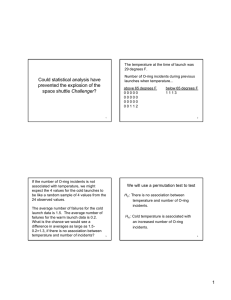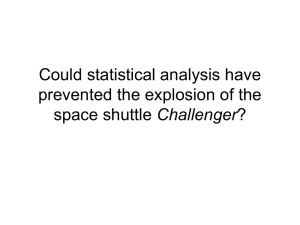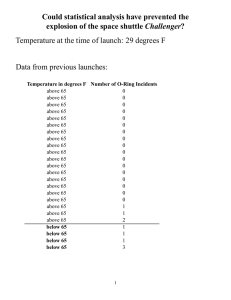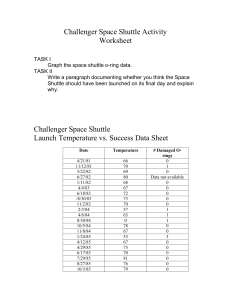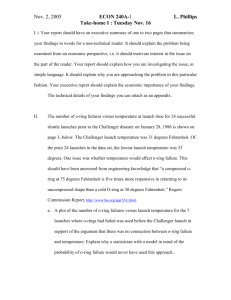STS.011 American Science: Ethical Conflicts and Political Choices MIT OpenCourseWare .
advertisement
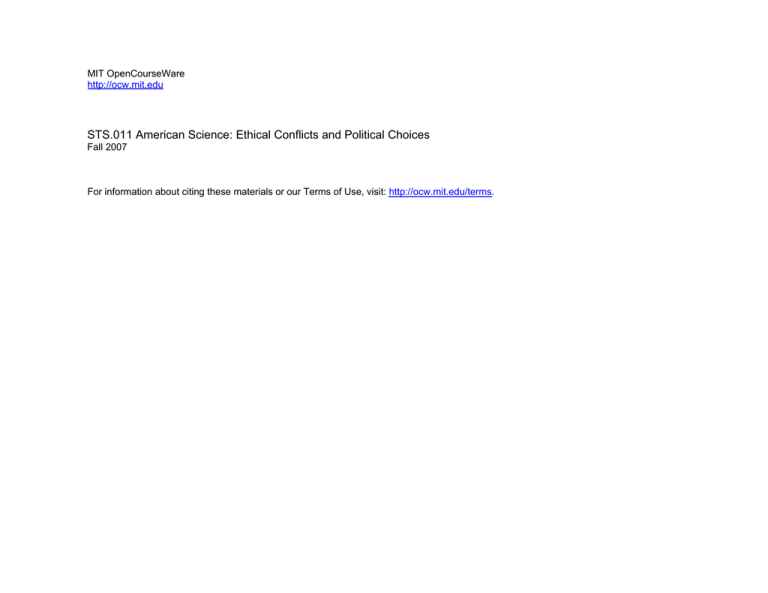
MIT OpenCourseWare http://ocw.mit.edu STS.011 American Science: Ethical Conflicts and Political Choices Fall 2007 For information about citing these materials or our Terms of Use, visit: http://ocw.mit.edu/terms. Engineering Ethics The Challenger Accident Jeffrey A. Hoffman - MIT 16.00 The Challenger Astronauts The ASTRO-1 Mission Launch Date 6 March, 1986 That morning… 28 January, 1986 Space Shuttle Stack External Tank Segments ET Interior ET Ready for Stacking Solid Rocket Booster Assembly Liftoff! SRB Ignition Response Before After P=0 T = ambient P ~ 900 psi T ~ 3000 F SRB Field Joint O-Ring Design SRB Recovery O-Ring Blowby SRB Field Joint O-Ring Design Primary O-ring Secondary O-ring Flight Readiness Reviews • • • • Review Launch Commit Criteria Consider anomalies from previous flights Show rationale for flying current flight Pressure for clear explanations Flight Readiness Evaluation for STS-51E • Evaluation Summary – STS-51C primary O-ring erosion on two field joints – STS-51C soot between primary and secondary O-rings on both field joints - first time observed on field joint – Evidence of heat effect on secondary O-ring … field joint but no erosion - first time heat effect on secondary O-ring has been observed Flight Readiness Evaluation for STS-51E (cont.) • Conclusion – STS-51C consistent with erosion data base • Low temperature enhanced probability - STS-51C experienced worst case temperature change in Florida history • Erosion in two joints observed before - STS-11 and -14 • STS-51E could exhibit same behavior – Condition is acceptable (limited exposure and redundancy) • STS-51E FIELD JOINTS ARE ACCEPTABLE FOR FLIGHT Special Factors for Challenger Launch • • • • Huge public attention because of teacher on board Previous flight had been delayed seven times Next mission important for space science community Commercial backlog building Eve of Launch SRB Teleconference • Cold front predicted with temperatures in the 20’s • Coldest previous launch was 53 F, with 3 “incidents” Eve of Launch SRB Teleconference (cont.) • Recommendation of Thiokol engineers (including Roger Boisjoly) was to create a new Launch Commit Criterion not to launch when the temperature was < 53 F • Recommendations: – O-ring temperature must be >53 deg F at launch (development motors at 47 to 52 deg F with putty packing had no blow-by. SRM-15 (the best “simulation”) worked at 53 deg F. – Project ambient conditions (temp & wind) to determine launch time Eve of Launch SRB Teleconference (cont.) • Reaction of NASA managers: “I’m appalled.” (George Hardy) “When do you want us to launch, Thiokol, in April?” (Larry Mulloy) • Thiokol management asked to pause for a short caucus Thiokol engineers presented their data one more time • One senior manager asked to “take off his engineering hat and put on his management hat.” • Four senior managers voted to recommend launch • Telecon resumed; decision announced and accepted • Higher-level NASA officials not informed about discussion That morning… 36 degrees F RH SRB had wind chill, saw 23 degrees earlier What would YOU have done? • • • • Management challenging engineers to prove danger Prove temperature sensitivity (communication) 53 degree temperature launch constraint “Put on your management hat…” Was cold weather a real threat? Was cold weather a real threat? (cont.) 53o 65o Was cold weather a real threat? (cont.) Knowledge is of limited value if you cannot communicate it to other people. Why constrain launches to >53 degrees? • We did it before and got away with it. What is a “Management Hat”? • Thiokol Senior Vice President Jerry Mason to Robert Lund, one of the four voting managers, who was hesitating to concur with a decision to recommend launching: “It’s time to take off your engineering hat and put on your management hat.” • Interpretation 1 - The engineering data shows a risk, but there are other (i.e. “management”) criteria that need to be considered as well which argue in favor of launching. • Public Interpretation of this remark - When you take off your “engineering hat” you can forget about safety. Like in an old western movie where you could tell the good guys from the bad guys by their hats! Hats (continued) • Alternative Interpretation: Rational analysis never leads to a decision either in classical ethics or in project management. At some point, you have to make a decision, even if some of the data is inconclusive. • This is the job of managers. “It’s time to take off your engineering hat” = “We asked for a 5 minute caucus, and we’ve now been talking for 30 minutes. All the available data has been presented.” “Put on your management hat” = “It’s now time to make a decision.” Roger Boisjoly’s Conclusions • The AIAA has published a code of ethics for their members, known as Rule 2.4 which states, “The member will indicate to this employer or client the adverse consequences to be expected if his judgement is overruled.” • More than 20 years ago I received some superb advice from a QA manager that I have applied throughout my career. He told me to ask myself the following question when faced with a tough question of whether a product was acceptable: "Would you allow your wife or children to use this product without any reservations?" If I could not answer that question with an unqualified, "Yes," he said, I should not sign off on the product for others to use. That is what ethical analysis of acceptable risk should be. Conclusions by Richard Feynman Let us ... ensure that ... officials deal in a world of reality in understanding technological weaknesses and imperfections well enough to be actively trying to eliminate them. They must live in reality in comparing the costs and utility of the Shuttle... And they must be realistic in making contracts, in estimating costs, and the difficulty of the projects. Only realistic flight schedules should be proposed, schedules that have a reasonable chance of being met. If in this way the government would not support them, then so be it. NASA owes it to the citizens from whom it asks support to be frank, honest, and informative, so that these citizens can make the wisest decisions for the use of their limited resources. Feynman Conclusions (cont.) For a successful technology, reality must take precedence over public relations, for NATURE CANNOT BE FOOLED.
